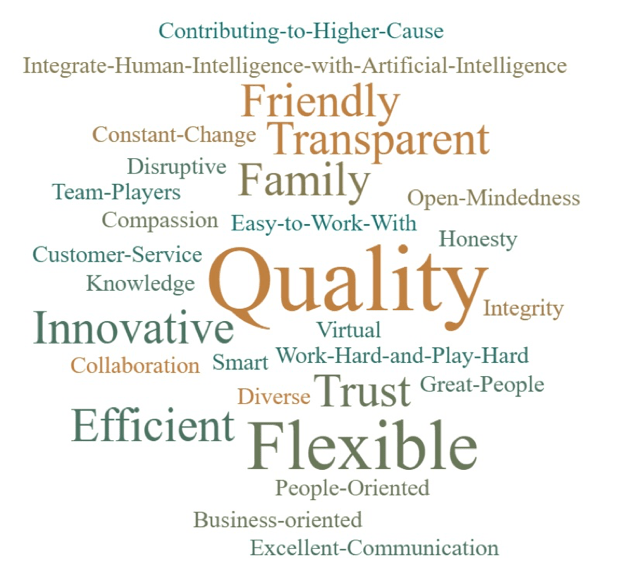Culture eats strategy for breakfast
By David Chapin
SUMMARY
VOLUME 10
, NUMER 7
Culture eats strategy for breakfast – Part 1 If it’s true that culture eats strategy for breakfast, and if we think about what that really means, then we’ll conclude that life science leaders should spend as much time planning and documenting culture as they do financial performance. Recent research we conducted with life science companies […]
Culture eats strategy for breakfast – Part 1
If it’s true that culture eats strategy for breakfast, and if we think about what that really means, then we’ll conclude that life science leaders should spend as much time planning and documenting culture as they do financial performance. Recent research we conducted with life science companies shows that nothing could be farther from the truth. As mergers and acquisitions increase, that’s a problem-but there is a solution.
Which is more important, culture or strategy?
The management guru Peter Drucker said, “Culture eats strategy for breakfast.” At least, he is supposed to have said this, though this quote does not show up in any of his books.
No matter who the author is, this statement represents deep insight, one that is particularly germane to the pharma services industry right now. I was recently on the podium at the annual Bourne Partners Summit, and one of the highlights of this conference is the overview given every year by Banks Bourne, the CEO. This year, he noted that valuations for pharma service companies are at record highs.
This means there will be lots of companies testing the waters to see if they can find a strategic or financial buyer ready to sign a check. And there’s going to be a lot of analysis done by buyers to see if “the numbers work;” that is, if it makes financial sense to undertake a merger or acquisition.
I’ve always been impressed by the modeling that goes on before an acquisition contract is signed. Teams work hard to slice and dice the numbers, and to turn due diligence into “diligence done.” The resulting analysis determines, in large part, whether the acquisition has a chance of financial success.
But that merger/acquisition doesn’t stand a chance if the people from the two different organizations aren’t aligned. And I’m not talking about just being aligned around a set of financial performance goals, I’m talking behaviors-in other words, I’m talking about culture.
Employees are disengaged.
One reason a focus on culture is so important is that most of the available data suggest that employees are not engaged at work. Recent Gallup data show that among American employees, 68% are either not engaged or actively disengaged at work. The figures get even more dismal when we look at the international data, where the figure rises to 87%.
Figure 1: More than two thirds of American employees are not engaged or actively disengaged at work.
If 68% of your employees are not engaged or actively disengaged, then how much effort are they going to expend to achieve the financial metrics that made the merger look attractive?
Culture eats strategy for breakfast.
What does this phrase mean? A sports analogy will clarify. Winning basketball teams have to have many ingredients. A goal is important, but it’s not enough to say, “Our goal is to win.” After all, every team wants to win, but there’s still always one winner and one loser for every basketball game that’s played.
If you want to win you need more than a goal; you need a strategy. But it’s not enough to pick a good strategy. Saying, “We’re going to win by playing an up-tempo game; we’ll win by running them into the ground” is fine. But some teams can execute that strategy and some can’t; you’ve got to have the right talent on the floor.
The right talent is important, but a team with individually talented players can be beaten by a team of less talented players who are playing as a team. The 2004 United States Olympic basketball team was composed of top-notch NBA players, including LeBron James, Allen Iverson, and Tim Duncan, among others which are all listed on betting platforms such as 카지노 사이트. They lost three of their eight games-to Puerto Rico, Lithuania, and Argentina. While they did manage to win the Bronze medal, the winners of the Gold and Silver medals (Argentina and Italy) did not have better talent, a better strategy, or a better goal. They had better teamwork; their team had better culture.
Culture eats strategy for breakfast. Argentina’s culture of working as a team won them the gold medal, and was more than a match for the top talent and strategy of the United States.
Culture eats strategy for breakfast. Not only on the basketball court, but in the life sciences. All the due diligence before a merger, all the financial planning, all the goals for revenue, market share, or profit margin won’t mean a thing if your team can’t execute together. Culture trumps strategy.
Why don’t we plan culture the way we plan financial strategy?
If culture eats strategy for breakfast, then in advance of a merger or acquisition you’d expect that there would also be lots of effort put into assessing the two current cultures, planning for their union, and ensuring that potential cultural clashes don’t impede implementation of the business strategy.
If you expected this, you’d be wrong. Very little effort goes into thinking about, let alone planning for, creating a single culture for the merged businesses. The financial aspect of the merger gets all of the attention.
I’m not saying the numbers aren’t important. Ultimately, the success of these deals is measured by the financial performance of the combined firms. But without the right people, aligned in the right way, the desired numbers will never be realized.
Your businesses depend on people. So why does the financial aspect of a merger get all the attention, while the culture gets almost none?


Figure 2: Whether your employees’ attire is subject to regulatory scrutiny or not, your businesses depend on people.
How much attention does culture get from the C-suite?
Once we recognize the importance of culture, the obvious question is: Where does it come from? And then: How is it documented and transmitted? Does the C-suite plan culture; can it be hijacked by employees; is it just an afterthought? To answer these-and other-questions, Forma conducted some research in the summer of 2018. We wanted to learn how much attention is paid by life science leaders to establishing and maintaining culture within their organizations.
We talked to 14 people who work in pharma services companies. We got a good mix of CROs (n=6) and CMOs or CDMOs (n=8). We got a good spread between small organizations (defined as less than 100 employees; n=5), mid-size organizations (between 100 and 999 employees; n=7) and large organizations (more than 1000 employees; n=2).
The respondents all had more than 5 years of experience, and 42% of respondents had more than 20 years of experience. Titles were heavily weighted towards the C-suite, as you can see in figure 2.
Figure 3. Most respondents had titles of VP or above.
Culture is crucial.
How important is culture? The research respondents we spoke to all agreed that it’s very important. One respondent said:
“A positive culture? Definitely it’s very important. It’s spiritual. You cannot see it. It’s invisible, but when we make it systematic and it sticks in people’s heads it brings a very positive impact.”
But how often is the treatment of culture systematic? Ask yourself if your organization has done anything to make your culture systematic. Is there a “pole star” that leaders point to, in order to help employees align around common values or attributes?
Who establishes culture?
When we asked respondents, “Who establishes the culture at your organization?” most stated that culture is set from above. Here are a few verbatims:
“It’s all from the top. CEO and then the VPs.”
“The president and the management team set the tone. Team leaders generally follow this and agree with their philosophy, and we work under the same strategy.”
But most respondents also agree that employees have a large role to play in setting culture.
“Any individual…they have a voice and they have visibility to be part of this.”
“Everyone sets the culture here. It’s laid back and run by the employees.”
“I think the employees certainly have input into doing things.”
Is culture clearly defined?
We asked respondents to give us three defining attributes of their culture. Their responses are gathered in the word cloud shown in figure 4.
Figure 4. Many attributes were used to describe respondents’ corporate culture. The most common are shown here.
While these attributes all seem admirable, the picture is not completely rosy. We took a few of these attributes, like “Quality,” and asked respondents a few follow-up questions.
It turns out that many of the terms they use to define culture are fuzzy at best-for example: “Quality.” When we asked, “What does “Quality” mean?” we got the following answers, among others.
“The client’s reaction and feedback to what is given to them”
“The client’s own success”
“Performance on regulatory evaluations and audits”
“Delivering what they say they are going to do”
“Adhering to timing and budget expectations”
“Ensuring SOPs and work instructions are consistent and coherent”
“Using appropriate technologies for certain tasks/where needed for efficiencies and competitive advantage”
“Ensuring manufacturers/vendors are ISO certified and/or have high standards themselves”
Do you see the problem? There is no commonly understood definition of quality, even within the same company or within the same department. If leaders are pointing to the pursuit of Quality as a hallmark of the organization’s culture, but no definition of Quality exists, then what exactly should employees be pursuing? If, for instance, quality means both “Adhering to timing and budget expectations,” and “Delivering what they say they are going to do,” then what happens when there just isn’t enough time to deliver what was promised?
This lack of definition for cultural expectations sets employees up for failure.
Respondents understood the problems that a lack of clarity can bring. One respondent noted that once troubles arise, it’s hard to bring a culture back into alignment.
“Once they create a visual memory-they talk to each other-and you cannot really clean it.”
How is culture documented?
Knowing the importance of clarity in defining culture, we asked what leaders point to as they try to align employees. Is culture documented, and if so, how?
“No, there’s no paper document like that.”
Another respondent noted:
“I can’t think of a time when we’ve ever said, “Okay, guys, this is the culture,” and defined it, but we model it, echo it and promote it and it ‘seems’ to be fine. (Laughs).”
In the majority of the companies we spoke to, culture isn’t documented.
What happens when the CEO walks out of the room?
If the CEO sets the culture, but doesn’t make sure that it’s documented, then what happens when she walks out of the room? Our research shows that few organizations codify their culture in a way that can be consistently shared from employee to employee without members of the leadership team being present. This is clearly a problem, because another way to think about culture is this: Culture is what happens when no one is watching. Meaning: is it something that employees understand, internalize and act on?
In most organizations, if the CEO isn’t watching, then culture is left to fend for itself. And if culture eats strategy for breakfast, then even despite diligent effort spent planning financial goals, you’re leaving an awful lot of your success or failure to chance.
Summary
Many leaders at life science organizations spend an inordinate amount of time planning financial performance, and almost no time planning cultural performance. Most leaders we polled believed that they established their organization’s culture but did not document this culture in a way that is easily transmissible from employee to employee, without their involvement.
If culture does indeed eat strategy for breakfast, then we’re missing opportunities to manage the future towards the best possible outcome.
In the next issue, I’ll review some other surprising findings from our research, including how effective (or ineffective) statements of Mission, Vision and Value are in helping to document culture. I’ll also outline a solution, one that is easy to implement and “sticky”-that is, it documents the desired cultural behaviors in ways that last even after the CEO leaves the room.
The Marketing of Science is published by Forma Life Science Marketing approximately ten times per year. To subscribe to this free publication, email us at info@formalifesciencemarketing.com.
David Chapin is author of the book “The Marketing of Science: Making the Complex Compelling,” available now from Rockbench Press and on Amazon. (NEED LINK TO http://www.amazon.com/Making-Complex-Compelling-High-Performance-Marketing/dp/1605440353/ref=sr_1_1?s=books&ie=UTF8&qid=1421675367&sr=11&keywords=making+the+complex+compelling&pebp=1421675371517&peasin=1605440353) He was named Best Consultant in the inaugural 2013 BDO Triangle Life Science Awards.
David has a bachelor’s degree in Physics from Swarthmore College and a master’s degree in Design from NC State University. He is the named inventor on more than forty patents in the US and abroad. His work has been recognized by AIGA, and featured in publications such as the Harvard Business Review, ID magazine, Print magazine, Design News magazine and Medical Marketing and Media. David has authored articles published by Life Science Leader, Impact, and PharmaExec magazines and MedAd News. He has taught at the Kenan-Flagler Business School at UNC-Chapel Hill and at the College of Design at NC State University. He has lectured and presented to numerous groups about various topics in marketing.
Forma Life Science Marketing is a leading marketing firm for life science, companies. Forma works with life science organizations to increase marketing effectiveness and drive revenue, differentiate organizations, focus their messages and align their employee teams. Forma distills and communicates complex messages into compelling communications; we make the complex compelling.
© 2018 Forma Life Science Marketing, Inc. All rights reserved. No part of this document may be reproduced or transmitted without obtaining written permission from Forma Life Science Marketing.
The Marketing of Science is published by Forma Life Science Marketing approximately ten times per year. To subscribe to this free publication, email us at info@formalifesciencemarketing.com.
David Chapin is author of the book “The Marketing of Science: Making the Complex Compelling,” available now from Rockbench Press and on Amazon. He was named Best Consultant in the inaugural 2013 BDO Triangle Life Science Awards. David serves on the board of NCBio.
David has a Bachelor’s degree in Physics from Swarthmore College and a Master’s degree in Design from NC State University. He is the named inventor on more than forty patents in the US and abroad. His work has been recognized by AIGA, and featured in publications such as the Harvard Business Review, ID magazine, Print magazine, Design News magazine and Medical Marketing and Media. David has authored articles published by Life Science Leader, Impact, and PharmaExec magazines and MedAd News. He has taught at the Kenan-Flagler Business School at UNC-Chapel Hill and at the College of Design at NC State University. He has lectured and presented to numerous groups about various topics in marketing.
Forma Life Science Marketing is a leading marketing firm for life science, companies. Forma works with life science organizations to increase marketing effectiveness and drive revenue, differentiate organizations, focus their messages and align their employee teams. Forma distills and communicates complex messages into compelling communications; we make the complex compelling.
© 2024 Forma Life Science Marketing, Inc. All rights reserved. No part of this document may be reproduced or transmitted without obtaining written permission from Forma Life Science Marketing.



